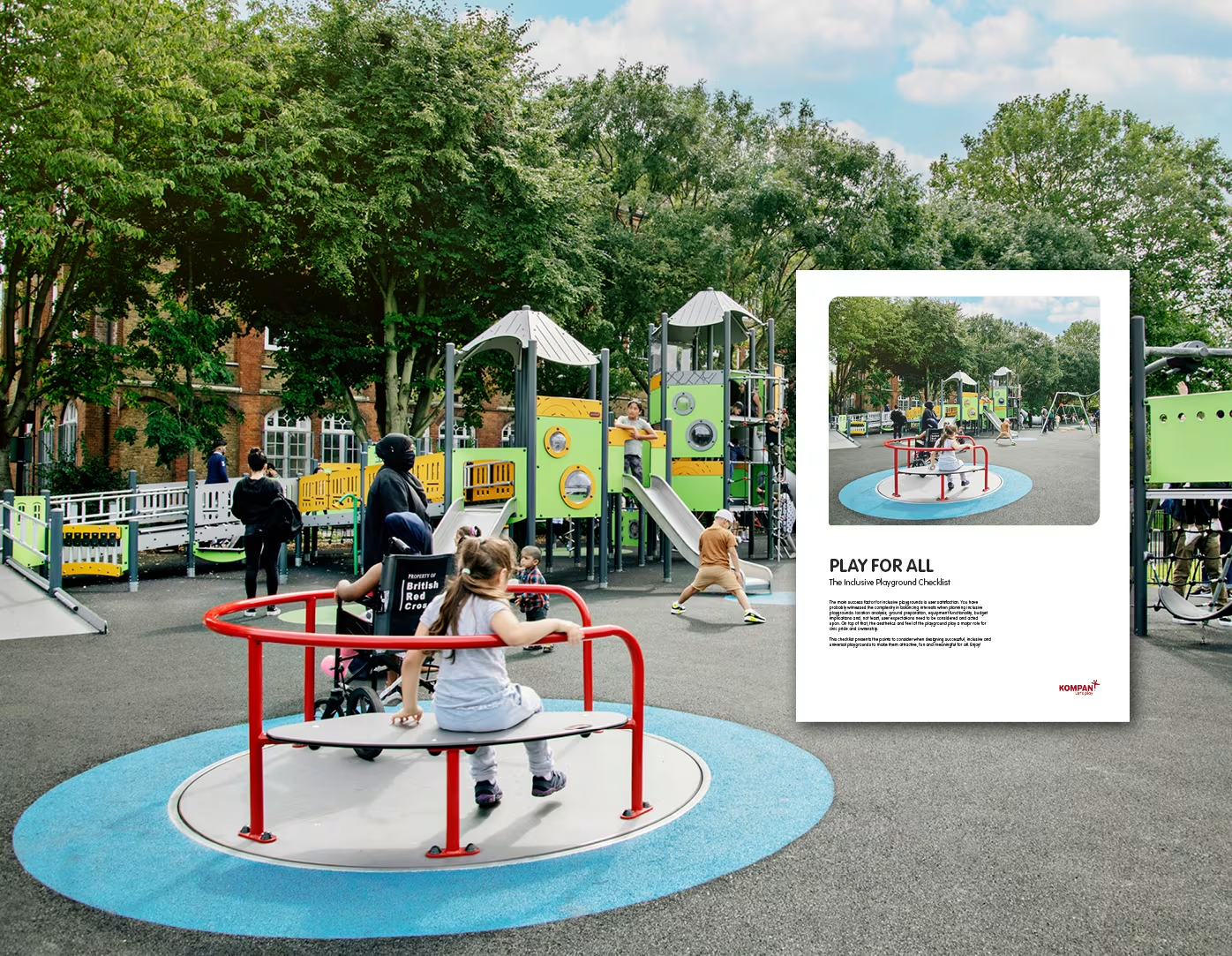kompan play institute
What is Inclusive Play?

The social connectedness of playing together in public playgrounds is an asset in equity and inclusion agendas. Since public playgrounds are for all citizens, planners should consider whether all can use them.
What is an inclusive playground?
Inclusion focuses on what people of all abilities can contribute instead of what they cannot do: the environment is disabling, not the people, if access is not possible. People of all abilities should be able to access, be included, and be invited to play in public playgrounds.
A truly inclusive playground caters to both invisible and visible disabilities, and follows the universal design principles:
Equitable use
Flexibility in use
Simple and intuitive to use
Perceptible information
Tolerance for error
Low physical effort
Size and space for approach and use
In a playground context, principle 6, low physical effort, is less relevant. A high physical thrill level often involves physical effort and is one of the very motivations of great playgrounds. The universal design principles were developed in the 1990s by design practitioners*. The principles have become widely acknowledged as a way of working with facilities that everybody can use to the widest possible extent.
* Seven Principles of Universal Design (Ron Mace et al, 1997)
Benefits of inclusive playgrounds

The rise in neurodiversity diagnoses, such as attention deficit hyperactivity disorder (ADHD), attention deficit disorder (ADD) or autism spectrum disorder (ASD), calls for additional measures to be considered.

1. Get Around
Accessible paths and safety surfacing are mandatory for access. Playgrounds needs paths wide enough to make space for assistants lead to play zones, and have safety surfacing that is accessible for all, including wheelchair users. A good, inclusive playground design applies the realistic rule of thumb that all users cannot do everything, but all users should be offered something, preferably as much as possible, that they can play on or with.

2. Stay
The inclusive design focuses on retention and extended stays, which means consideration of users’ need for variation, zones of diverse play, and points for breaks. If these points are relatively close to the playground, children needn’t fear that the break is the end of play. Benches generously spread for breaks at the play zones make it possible for users with walking problems to stay longer in the playground, whether young or old.
3. Play
Variation in play activities is mandatory for inclusive playground success. Thrill activities should never be underwhelming in the thrill or activity level since thrill is a success factor for all children across abilities. But should appeal to more than the daredevils only. Respect the desire for social play for smaller and bigger groups of children and the need for individual play, for instance, at play panels or on single-use active play equipment, is essential.
Free Magasine
Universal Inclusion in Playgrounds
A peek of what you get
A walkthrough of the best-in-class design principles behind an inclusive playground
A thorough checklist to get your inclusive design right
Inspirational inclusive cases from around the world
Our recommendation for the best inclusive playground products
Download your magazine below.
How to ensure invisible inclusion for all
The three design principles should not only consider visible disabilities, but also neuro-diversity disabilities.
Accessibility as a neurodiversity-friendly asset means help with wayfinding in the playground. Maps, signs and play zone guidance will help many users, especially those with difficulties navigating many sensory impressions at a time, including many users with AD(H)D or ASD. Good maps for wayfinding at the entrance and an entrance that offers seating will help. Recognisable markers of routes to wilder and quieter play areas and respite areas are helpful.
When designing neurodiversity-friendly playgrounds, edges of functionality should be signalled. Using colour and texture contrasts around play zones and signalling changes in types of play activities will help guide users in seeking out or avoiding certain activities. Responsive play activities, such as swings, rotating equipment or slides, can be marked out with contrasting colour dots in the surfacing under them to assist users. For users with vision impairments, the textures in the ground and contrasting colours around play zones can help with wayfinding and functionality indications; for example, explanatory signs that aid communication will help many.
KOMPAN Play Institute research
Ever since the 1990s, children of all ages and abilities have been included and heard in the research and development process with the KOMPAN Play Institute.
The KOMPAN Play Institute is KOMPAN’s unit of play specialists, dedicated to researching, developing and documenting trends in children’s and families’ play in playgrounds. The institute is essential to KOMPAN’s child-centred play agenda and comprises trained scholars and researchers with certified course materials.
Equity in playground access
Equity is a United Nations’ Sustainable Development Goal. It is a fundamental part of happier, healthier, and more sustainable communities. However, not everyone is equal regarding access to leisure offerings and playgrounds. Children with disabilities participate far less in active play and physical activity than their peers. Since active play is one of the main contributors to child health, the accessibility to and usability of public playgrounds for children of all abilities is fundamental for their physical and social-emotional well-being and health.
What's happening in the world of play?
Be the first to know about the newest play equipment, catalogues, insights, and inspiration. Fill in the boxes, and you are all set.







